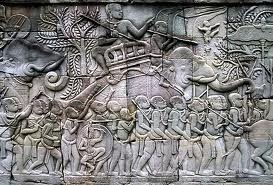Photo Gallery of Bayon Temple
History of Bayon Temple
Bayon Temple
Date late 12th - early 13th centuryKing Jayavarman VII
(posthumous name: Maha paramasangata pada)
Cult Buddhist
Study H. Dufour and Ch. Carpeaux
(1901 - 1902 - 1904)
Clearing Commaille 1911 to 1913
Consolidation of central tower by G. Trouvé in 1933
Anastylosis of the four-faced towers and of the central tower by M. Glaize from 1939 to 1946
 |
| Bayon Temple |
 |
| Bayon Temple see from beside |
 | ||
Bayon Temple see from the left side
|
 |
Bayon Face |
THE BAS-RELIEFS
The Bayon is the only temple to have two concentric galleries sculpted with bas-reliefs; - the internal gallery is complete in its ornamentation and was almost exclusively reserved for mythological subjects of Brahmanic inspiration, while the outer gallery, accessible to the mass of the faithful, was dedicated both to scenes of everyday life and to certain historic episodes - processions and battles - from the reign of Jayavarman VII. Remaining incomplete, these were to have shown - according to Paul Mus - scenes of contemporary mythology under the aegis of Lokesvara, of whom the deified king himself was but an emanation, given life by the sculptor's chisel.The Bayon bas-reliefs are less stylised and more deeply incised than those of Angkor Wat, and although often quite crude in execution and simplistic in form, they provide a source of documentation which is remarkable, both for the care taken in the representation of the smallest detail and for the qualities of observation which they show - and it is practically the only source we have that gives an idea of the customs and conditions of life in ancient Cambodia.
They are sculpted in superposed registers, with the lower panel representing, for the ancient Khmer who were ignorant of the laws of perspective, the foreground, and the upper panel the horizon. Starting from the eastern entrance, we begin with the southern section of the eastern side, keeping the monument to our right in accordance with the rite of "pradakshina".
SOUTH EAST CORNER PAVILION
The sculptures of this gallery remain unfinished, with the first panel giving a good indication of the working methods of the Khmer. Passing a wall that has first been prepared (and of which one should note the unlikely bonding), they proceed with the direct sculpting first drawn in sketch, - then slightly relieved, - then given volume - and finally finished. Two charming apsaras dance to the right, while to the left are outlined three towers surmounted by a trident. The central shelters a linga.The other panels are dedicated to nautical scenes.
EAST GALLERY, NORTHERN PART
In a large deployment, Cham and Khmer forces are again in battle, forming a furious melee towards the centre with the elephants themselves also taking part in the action. One of them tries, with his coiled trunk, to pull a tusk from another who opposes him. Another is unusually represented from the front. Countless standards, banners and sunshades form a veritable back-cloth - and one can see, on the side of the Khmer who seem finally to dominate, some curious grilled panels that were perhaps designed to stop the arrows from the adversary without obscuring the view. |
| Plan of Bayon Temple view from the top |
AROUND THE BAYON
Around the quadrilateral of roads surrounding the Bayon, one can see - apart from the enormous gilded statues of the Buddha of a much later period which are to be found to the north and south - two modern commemorative monuments. The one in the south-west corner is the grave of Commaille, the first Angkor Conservator, who was assassinated in 1916 by armed robbers. The other, in the north-west corner and not far from the sculpture depot of the École Française d'Extrême-Orient and the old house of Commaille, is the stele erected in honour of Ch. Carpeaux, who died in service in 1904.If one takes the other section of the route Carpeaux, one will find, halfway between the Bayon and the west gate of Angkor Thom - at 200 metres south of the road - a small monument that is unnamed but classified as number "486".







No Comment to " Bayon Temple - Photo Gallery "